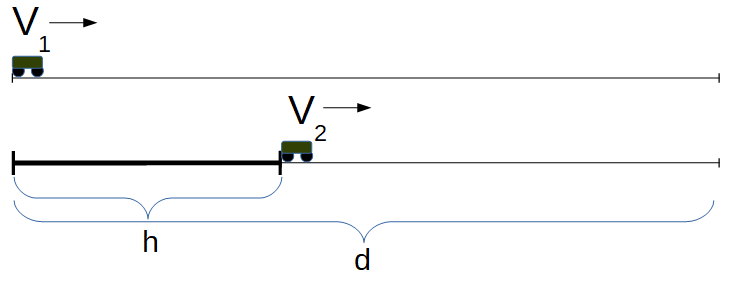Speed to Overtake by Distance
vCalc Reviewed
`V_1 = ( "d" * V_2 )/( "d" - "h" )`
Tags | |
UUID | b7bcab0e-72f7-11e8-abb7-bc764e2038f2 |
The Speed to Overtake by Distance calculator computes the average speed required to overtake a vehicle based on the speed of the vehicle, the head start, and the total distance.
INSTRUCTION: Choose units and enter the following:
- (h) Distance between Vehicles (i.e. the head start)
- (V1) Velocity of Chase Vehicle
- (d) Distance over which Chase Vehicle must catch Lead Vehicle
Speed to Overtake (V1) The calculator returns the speed in miles per hour. However, this can be automatically converted to compatible units via the pull-down menu.

Related Calculators
- Time to Overtake: Computes the distance in which the overtake will occur at constant velocities.
- Distance to Overtake: Computes the distance in which the overtake will occur at constant velocities.
- Speed to Overtake by a Distance: Computes the speed required to intercept within a distance boundary.
- Speed to Overtake in Time: Computes the speed required to intercept within a time boundary.
The Math / Science
The formula for the speed required to overtake is:
V1 = (d•V2) / (d - h)
where:
- V1 is the velocity or speed to overtake
- d is the distance required at the specified velocities for vehicle 1 to overtake vehicle 2.
- h is the distance between the vehicles or the head-start.
- V2 is the velocity of vehicle two.
Vehicle Calculators
- Approach (Departure) Angle: Computes the maximum angle of a ramp onto which a vehicle can climb without scraping.
- Degree to Percent Grade: Converts a grade to a degree angle.
- Camber angle - Wheel camber (tilt) calculation of angle
- Camber offset - Wheel camber (tilt) calculation of offset
- Breakover Angle: Compute maximum angle that a vehicle can drive over without the ground touching the vehicle's undercarriage.
- Time to Overtake: Computes the time for one object to overtake another.
- Distance to Overtake: Computes distance traveled to overtake another.
- Speed to Overtake: Computes the average velocity to overtake another.
- Distance at Speed: Computes the distance traveled over a period of time at a constant velocity (speed).
- Speed from Skid Marks: Estimates the speed of a vehicle based on length of skid marks.
- Braking Distance: Estimates distance to stop a vehicle based on initial velocity and braking coefficient.
- Total Stopping Distance: Computes the distance to stop a vehicle based on the initial velocity, reaction time and a braking coefficient.
- Speed from the Braking Distance: Estimates the initial speed based on the distance to stop a vehicle and the a braking coefficient.
- Used Car Price Comparison: Estimates the better value between two vehicles based on their mileage, cost and expected lifespan (miles).
- Belt Length: Computes the length of a belt that goes around two pulleys based on the pulley diameters and the distance between the axles.
- Belt Speed: Computes the speed at which a linear length of belt travels around a pulley based on the diameter of the pulley and the rotation rate.
- Pulley RPMs: Computes the RPMs of a pulley based on the belt speed and diameter of the pulley.
- 2nd Pulley RPMs: Computes the RPMs of a second pulley based on the the RPMs and Diameter of the first pulley and the diameter of the second pulley.
- 2nd Pulley Diameter: Computes the diameter of a second pulley based on the RPMs and diameter of the first pulley and the RPMs of the second pulley.
- RPM of 4th pulley on three shafts: Computes the RPMs (rotation rate) of a pulley when the RPM and Diameters are known for a series of pulleys on three axles.
- 2nd Gear RPM: Calculates the RPMs of a second gear when the RPMs and number of teeth are known for the first gear and the number of teeth of the second gear is known,
- 2nd Gear Torque: Calculates the torque of a second gear when the torque and number of teeth are known for the first gear and the number of teeth of the second gear is known,
This equation, Speed to Overtake by Distance, is used in 3 pages
Calculators
Collections
- Comments
- Attachments
- Stats
No comments |
This site uses cookies to give you the best, most relevant experience. By continuing to browse the site you are agreeing to our use of cookies.

